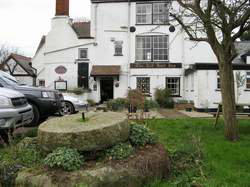Abandoned Communities ..... Woodend
Ships travelling up the estuary from Bristol or further afield would often land their cargoes at Gatcombe, a few miles south of Woodend. However, there was a wharf at Woodend, described as a free wharf, where stone and other building materials were brought ashore. The map on the first page of this section shows a limekiln close to Woodend Lane. Presumably the location of the limekiln was chosen because there was a wharf nearby.
Piracy was feared in the fifteenth century, when the traders of Tewkesbury complained about common people from the Forest of Dean boarding their boats, looting them, and hewing the craft in pieces. I do not know whether pirates were still active in the eighteenth century.
Drowning and shipwrecks occurred from time to time. Directly offshore from Woodend a large sandbank known as The Noose was notorious for its dangers. Rudge, in his history of Gloucester, states that “a few years hence” the hazard had been increased by the wreck of a brig from Newnham, but by the time he came to write his history the wreck had been raised. He may have been referring to a major incident in 1731, when a Newnham trow went down off Awre Point. Four people managed to get to shore in a small boat, but the owner of the trow and 17 passengers were drowned.
T Rudge, The History of the City of Gloucester, Compressed, and Brought Down to the Year 1803, Volume II, p114.
In St Andrews church in Awre there is an ancient and very splendid wooden chest. Its original purpose may have been to hold documents and vestments, but in addition it is believed that corpses recovered from the Severn were placed in it until their burial.
While much of the income of the people of Woodend may have come from the estuary it is likely that they also engaged in local farming activities. In particular the Awre promontory was renowned for its orchards where apples and pears were grown. The Tithe map of 1840, mentioned above, shows two orchards named “Woodend Orchard” and several others along both sides of Woodend Lane, the lane that led from Awre to Woodend. From the sixteenth century cider was made by pulping apples with a large disc shaped stone drawn by a horse over a circular stone trough (see photograph on the left for a surviving example).
Piracy was feared in the fifteenth century, when the traders of Tewkesbury complained about common people from the Forest of Dean boarding their boats, looting them, and hewing the craft in pieces. I do not know whether pirates were still active in the eighteenth century.
Drowning and shipwrecks occurred from time to time. Directly offshore from Woodend a large sandbank known as The Noose was notorious for its dangers. Rudge, in his history of Gloucester, states that “a few years hence” the hazard had been increased by the wreck of a brig from Newnham, but by the time he came to write his history the wreck had been raised. He may have been referring to a major incident in 1731, when a Newnham trow went down off Awre Point. Four people managed to get to shore in a small boat, but the owner of the trow and 17 passengers were drowned.
T Rudge, The History of the City of Gloucester, Compressed, and Brought Down to the Year 1803, Volume II, p114.
In St Andrews church in Awre there is an ancient and very splendid wooden chest. Its original purpose may have been to hold documents and vestments, but in addition it is believed that corpses recovered from the Severn were placed in it until their burial.
While much of the income of the people of Woodend may have come from the estuary it is likely that they also engaged in local farming activities. In particular the Awre promontory was renowned for its orchards where apples and pears were grown. The Tithe map of 1840, mentioned above, shows two orchards named “Woodend Orchard” and several others along both sides of Woodend Lane, the lane that led from Awre to Woodend. From the sixteenth century cider was made by pulping apples with a large disc shaped stone drawn by a horse over a circular stone trough (see photograph on the left for a surviving example).
Three
Ancient chest, lying on the floor at the base of the church tower
Trough and pressing stone used in the extraction of apple juice

